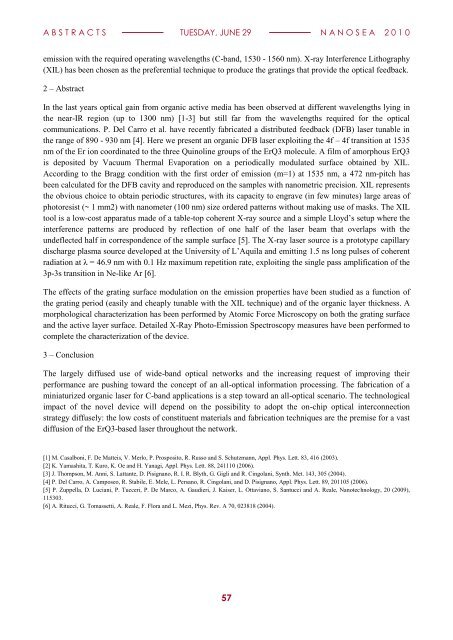book of abstracts - IM2NP
book of abstracts - IM2NP
book of abstracts - IM2NP
Create successful ePaper yourself
Turn your PDF publications into a flip-book with our unique Google optimized e-Paper software.
A B S T R A C T S TUESDAY, JUNE 29 N A N O S E A 2 0 1 0<br />
emission with the required operating wavelengths (C-band, 1530 - 1560 nm). X-ray Interference Lithography<br />
(XIL) has been chosen as the preferential technique to produce the gratings that provide the optical feedback.<br />
2 – Abstract<br />
In the last years optical gain from organic active media has been observed at different wavelengths lying in<br />
the near-IR region (up to 1300 nm) [1-3] but still far from the wavelengths required for the optical<br />
communications. P. Del Carro et al. have recently fabricated a distributed feedback (DFB) laser tunable in<br />
the range <strong>of</strong> 890 - 930 nm [4]. Here we present an organic DFB laser exploiting the 4f – 4f transition at 1535<br />
nm <strong>of</strong> the Er ion coordinated to the three Quinoline groups <strong>of</strong> the ErQ3 molecule. A film <strong>of</strong> amorphous ErQ3<br />
is deposited by Vacuum Thermal Evaporation on a periodically modulated surface obtained by XIL.<br />
According to the Bragg condition with the first order <strong>of</strong> emission (m=1) at 1535 nm, a 472 nm‐pitch has<br />
been calculated for the DFB cavity and reproduced on the samples with nanometric precision. XIL represents<br />
the obvious choice to obtain periodic structures, with its capacity to engrave (in few minutes) large areas <strong>of</strong><br />
photoresist (~ 1 mm2) with nanometer (100 nm) size ordered patterns without making use <strong>of</strong> masks. The XIL<br />
tool is a low-cost apparatus made <strong>of</strong> a table-top coherent X-ray source and a simple Lloyd‟s setup where the<br />
interference patterns are produced by reflection <strong>of</strong> one half <strong>of</strong> the laser beam that overlaps with the<br />
undeflected half in correspondence <strong>of</strong> the sample surface [5]. The X-ray laser source is a prototype capillary<br />
discharge plasma source developed at the University <strong>of</strong> L‟Aquila and emitting 1.5 ns long pulses <strong>of</strong> coherent<br />
radiation at λ = 46.9 nm with 0.1 Hz maximum repetition rate, exploiting the single pass amplification <strong>of</strong> the<br />
3p-3s transition in Ne-like Ar [6].<br />
The effects <strong>of</strong> the grating surface modulation on the emission properties have been studied as a function <strong>of</strong><br />
the grating period (easily and cheaply tunable with the XIL technique) and <strong>of</strong> the organic layer thickness. A<br />
morphological characterization has been performed by Atomic Force Microscopy on both the grating surface<br />
and the active layer surface. Detailed X-Ray Photo-Emission Spectroscopy measures have been performed to<br />
complete the characterization <strong>of</strong> the device.<br />
3 – Conclusion<br />
The largely diffused use <strong>of</strong> wide-band optical networks and the increasing request <strong>of</strong> improving their<br />
performance are pushing toward the concept <strong>of</strong> an all-optical information processing. The fabrication <strong>of</strong> a<br />
miniaturized organic laser for C-band applications is a step toward an all-optical scenario. The technological<br />
impact <strong>of</strong> the novel device will depend on the possibility to adopt the on-chip optical interconnection<br />
strategy diffusely: the low costs <strong>of</strong> constituent materials and fabrication techniques are the premise for a vast<br />
diffusion <strong>of</strong> the ErQ3-based laser throughout the network.<br />
[1] M. Casalboni, F. De Matteis, V. Merlo, P. Prosposito, R. Russo and S. Schutzmann, Appl. Phys. Lett. 83, 416 (2003).<br />
[2] K. Yamashita, T. Kuro, K. Oe and H. Yanagi, Appl. Phys. Lett. 88, 241110 (2006).<br />
[3] J. Thompson, M. Anni, S. Lattante, D. Pisignano, R. I. R. Blyth, G. Gigli and R. Cingolani, Synth. Met. 143, 305 (2004).<br />
[4] P. Del Carro, A. Camposeo, R. Stabile, E. Mele, L. Persano, R. Cingolani, and D. Pisignano, Appl. Phys. Lett. 89, 201105 (2006).<br />
[5] P. Zuppella, D. Luciani, P. Tucceri, P. De Marco, A. Gaudieri, J. Kaiser, L. Ottaviano, S. Santucci and A. Reale, Nanotechnology, 20 (2009),<br />
115303.<br />
[6] A. Ritucci, G. Tomassetti, A. Reale, F. Flora and L. Mezi, Phys. Rev. A 70, 023818 (2004).<br />
57

















